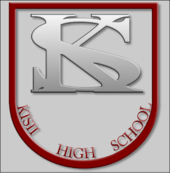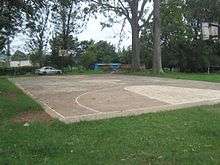Kisii School
 | |
| Motto | Strive For Excellence |
|---|---|
| Type | Government National Secondary School |
| Established | 1934 |
| Founder | Young Kavirondo Association |
| Principal | Mr. Caspar Maina Momanyi |
Administrative staff | >100 |
| Students | >1500 |
| Location |
Kisii, 40200, Kenya 0°41′13″S 34°47′04″E / 0.687°S 34.7845°ECoordinates: 0°41′13″S 34°47′04″E / 0.687°S 34.7845°E |
| Colours | dark green, grey, gold |
| Website | kisiischool.ac.ke |
Kisii School is a public National boys' school in Kisii, Kenya. It is a non profit public institution established in 1934 (by the Young Kavirondo Association) to provide secondary education to young pupils.
Immediately after the Colonial Government become interested in education, following the Phelps-Stokes Commission report of 1925, Kisii School started in 1934 as Government African School (GAS). The local Native Council of South Kavirondo raised the funds. It is one of the three 'K' schools which were started by the natives. These schools include; Kisii School, Kakamega Boys School and Kagumo High in central province. They were referred to as government African schools (GAS)
History
1934- Started Artisan courses at Primary School (Std. equivalent to STD 4-6). But when, it was unable to get pupils, the school admitted pupils in the sub standard level (equivalent of standard 2 and 3) with 15 pupils.
1938- Presented the first candidate for Primary School Examinations. By now, the school had 60 pupils in 2 streams of 30 each. The students had to be 50% Kisii and 50% Luo (Kisii 30 Pupils, Luo 30 pupils)
1945- The Secondary School section was started. At that time, this was called the Junior Secondary- equivalent to standard 7 and 8. The population was still 60 per class.
1946 - Presented the first student for Kenya African Preliminary Examination.
1949 - Started the senior secondary (from 3 and 4) These candidates were to be prepared for KASSE (Kenya African Secondary School Examination)
1950 - Presented candidates for KASSE (Kenya African Secondary School Examination)
1953 -The school admitted candidates for a P3 teacher training course which lasted 3 years. It was later shifted to Kabianga Teachers College (present day Kabianga Boys) before later on moving to present day Kericho Teachers Training College.
1956 - The school entered its first candidates for Cambridge School Certificate. A total of 60 students were registered.
1962- The school was among the 6 schools to introduce 'A' LEVEL (Art) with a single stream of 30 students.
1963 - Presented its first Higher School Certificate candidates commonly referred to as 'A' Level Examination.
1967 - The 'A' level science class or science stream was started. By now, the student population was 450 (form 1 to 6)
The school
The school has had a strong connection to the Musa Nyandusi family, a Senior Chief during the colonial era. This was the most powerful position akin to a king answerable only to the colonial authority with minimal supervision.The Land on which the entire school stands was donated by Senior Chief Musa Nyandusi The school has produced the likes of Simeon Nyachae, a son of Musa.
Curriculum
The secondary school curriculum emphasizes job-oriented courses, such as business and technical education.
Kisii School offers a college preparatory program following the Kenya Certificate of Secondary Education curriculum. The curriculum offered at the school covers six areas: Communication, Mathematics and Sciences, Humanities, Applied Education, Physical Education.
- Communication - English, Kiswahili,French and German
- Sciences - Mathematics, Chemistry, Biology and Physics
- Humanities - Geography, History and Government, Religious education, Social education, and Ethics
- Applied Education - Agriculture, Industrial education, Wood technology, Metal technology, Power mechanics, Electrical technology, Business education (Accounts, Commerce, Economics), Music, Fine Arts, Drawing and Design, Information Technology (computer studies).
- Physical Education -
Governance
Kisii School is a National Public School and it receives a large amount of public money from the government. The Board of Governors(B.O.G.) and the Parent Teachers Association(P.T.A.) oversee smooth running of the institution. Daily routine business of the school is headed by the Office of the Principal.
Admission
Admission of students is by open competitive K.C.P.E. examination every year.
Procedure
Candidates are judged according to need and parental income and their performance in the national KCPE examinations. Selection is solely based on merit.
Scholarships and financial support
Support comes from Government, organisations, individuals and donors.
Student Life
The school has dormitories, dining hall, classroom block, and Computer and Science laboratories. There are Technical Education workshops fors Woodwork, Metal work, Electricity, Power mechanics, and Agriculture. Students partake in watering of the livestock and vegetables from which meat and greens for meals is outsourced.


Houses
The school has eight houses. They are:
- Sameta Light blue,
- Mara Light Grey,
- Kuja Navy Blue,
- Kiong'anyo White,
- Manga Yellow,
- Homa Orange,
- Ruri Green,
- Wire Red,
Inter-house competitions
There are activities in which the houses compete - Science congress, athletics, cross-country, ball games, drama and academics.
The school principal, Mr Casper Maina Momanyi usually offers a reward for the top three houses in each field.
Extracurricular activities
Extracurricular activities include drama, choir, publications such as the School Magazine; school leadership through the prefects' body, Sunday School teaching, Scouting, Debate Club, Wildlife Club, Environmental Club, Journalism Club, Science Club, Computer Club, SDA Society, CU and YCS for the Catholics.
Sports
Choices include basketball, rugby, soccer, track and field, hockey, volleyball, handball, swimming, and lawn tennis. Individuals and teams have won national and regional honours in almost all of them.

Under the leadership of John L. O Kinaro,(1991–1998) a former principal, Kisii school emerged as the best soccer school teams in the 1990s. The record they set can only be rivaled by Kakamega Boys High School. They won three consecutive national championships between 1996 and 1999. Most of the team members have played for the national team, and some are playing professional football in Europe and Asia.
Notable Alumni and Academics
- Ratemo Michieka - former Vice Chancellor of Jomo Kenyatta University
- John Machethe Muiruri - Belgium 1st division soccer mid-fielder
- Simon Mulama - former Mathare United footballer
- Simeon Nyachae - former Leader Ford People and minister of Roads and Transportation in Kenya. He vied for a presidential post in the 2002 election
- George Nyamweya - Member of the National Assembly
- Henry Nyandoro - former Shabana Kisii and Kenyan International Footballer
- Kevin Omondi - Engineer based in the United States of America (USA)
- Robert Ouko - Athlete 400 Relay Gold Medalist at the 1972 Munich Olympics
- Japheth Onyaru Nyakundi - C.E.O Japh Designs
- CPA George Ombati-Strathmore Business School
KHOBA
KHOBA (Kisii High Old Boys Association) networks the schools alumni communit CPA George Ombati
External links
- Official site by school http://www.kisiischool.ac.ke/
- Alumni sponsored site http://kisiischool.com/
- Alumni site http://alumni.kisiischool.com/